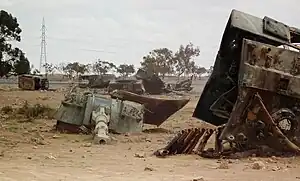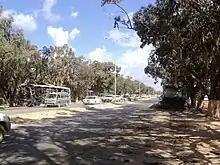| Second Battle of Benghazi | |||||||
|---|---|---|---|---|---|---|---|
| Part of Libyan Civil War | |||||||
 Remains of two Palmaria heavy howitzers of the Gaddafi forces, destroyed by French warplanes on the west-southern outskirts of Benghazi, in Opération Harmattan on 19 March 2011. | |||||||
| |||||||
| Belligerents | |||||||
|
| |||||||
| Strength | |||||||
|
8,000 defected soldiers (rebel claim)[3] 20 French fighter jets[4] | Unknown | ||||||
| Casualties and losses | |||||||
|
261 killed*[5] MiG-23 shot down[6] |
27–30 killed;[7] 50 captured;[8] 70 vehicles destroyed:[9] 14 tanks or SP howitzers, 20 APCs, 2 mobile MRLs, 1 mobile SAM[10] and 33 jeeps, SUVs, technicals or trucks;[11] 4 tanks captured[12] | ||||||
| *The number of dead on the rebel side includes both opposition fighters and civilians | |||||||
The Second Battle of Benghazi was a battle in the Libyan Civil War between army units and militiamen loyal to Libyan leader Muammar Gaddafi, and anti-Gaddafi forces in Benghazi.[12] The battle marked the start of a United Nations-mandated military intervention in the conflict, with fighter jets from the French Air Force attacking and destroying several pro-Gaddafi units, forcing them to retreat.[13]
On 18 March, Gaddafi's forces bypassed Ajdabiya by using the coastal roads instead of the roads directly linked with Ajdabiya, avoiding the need to capture Ajdabiya to proceed. By night the loyalist troops had positioned themselves within kilometres of Benghazi's two southern entry points, the western southern gate being called the west gate.
Battle
Initial assault on the city

At 7:30 am local time on 19 March, Gaddafi's forces began artillery shelling the city. At around 9:00 am local time they entered the city from west and south with tanks.[14] Rebel armoured units engaged the initial loyalist armoured column at around 10:00 am.[15] Twelve T-72 tanks spearheaded the main thrust into the city, and by 10:30 am, it seemed the Benghazi was in danger of falling to Pro Gaddafi forces. A rebel tank, aging and rusted, opened fire on the lead pro Gaddafi tank, damaging it and forced its occupants to abandon the vehicle. The tanks behind the lead vehicle all began a withdrawal from the area, under rebel fire, and retreated apparently to the city limits.
By 2:30 pm local time the opposition fighters had repelled the first wave of loyalist forces out of the city. During the daytime battles, a rebel MiG-23 crashed to the ground in the outskirts of Benghazi.[16] The pilot, Colonel Mohammed Mbarak al-Okaili,[16] remained in the plane until moments before the crash before ejecting but was reported not to have survived the crash.[17] The cause of the crash was unclear, but may have been a catastrophic engine failure or friendly fire from rebel air-defences that had mistaken it for a loyalist plane.[18] This prompted rebels to use loudspeakers, mainly from mosques, urging not to attack the planes.
France intervenes, loyalists retreat
At around 4:00 pm local time, French fighter jets entered Libyan airspace and flew over Benghazi, conducting aerial reconnaissance missions and preparing to intervene.[14] Then, at 4:45 pm, coalition intervention began as a French fighter jet fired on and destroyed several loyalist armored vehicles.[14] Later, Al Jazeera reported that French fighter jets had destroyed at least four of the regime's force's tanks; however, this was not confirmed by France.[19]
On the morning of the next day, air attacks were conducted against a loyalist tank column from 4:00 am for two hours. It was confirmed by a Reuters reporter that at least seven tanks and two armored personnel carriers were destroyed in the French air strikes.[11][20]
Admiral Mullen of the United States announced on 20 March, that the international coalition had stopped the regime's progression on Benghazi.[13]
References
- ↑ "UN clears way for Libyan no-fly zone". ABC News. 18 March 2011. Retrieved 27 January 2012.
- ↑ "French strikes destroy tanks near Benghazi". Euronews. 19 March 2011. Retrieved 27 January 2012.
- ↑ "Battle for control rages in Libya". Al Jazeera. 15 March 2011. Retrieved 27 January 2012.
- ↑ "Libye : "une vingtaine d'appareils" engagés" [Libya: "twenty units" engaged]. Europe 1 (in French). Agence France-Presse. 19 March 2011. Retrieved 27 January 2012.
- ↑ 850 total killed in Benghazi, of which 589 died in other incidents, Casualties of the 2011 Libyan civil war#Timeline of reported deaths per event leaving 261 dead during the second battle
- ↑ "Mig-23 shot down over Benghazi". 19 March 2011.
- ↑ 2 mercenary infiltrators killed, Archived 19 October 2012 at the Wayback Machine 9 -12 killed in street fighting, 16 killed in tank column , total of 27-30 reported killed
- ↑ "A Gadhafi soldier speaks". CNN. 29 March 2011. Retrieved 29 March 2011.
- ↑ "U.S. official: Gadhafi's momentum stopped". CNN. Tripoli. 21 March 2011. Retrieved 27 January 2012.
- ↑ "Photo Gallery: The bombardment of Libya". Der Spiegel. 21 March 2011. Retrieved 27 January 2012.
- 1 2 Abbas, Mohammed (20 March 2011). "Remains of Gaddafi's force smolders near Benghazi". Reuters. Benghazi and Ajdabiya Road. Retrieved 27 January 2012.
- 1 2 Abbas, Mohammed (19 March 2011). "Rebels say they repulse Gaddafi attack on Benghazi". Reuters Africa. Benghazi. Reuters. Archived from the original on 22 March 2011. Retrieved 27 January 2012.
- 1 2 "Libya Live Blog - March 20". Al Jazeera. 20 March 2011. Archived from the original on 21 March 2011. Retrieved 11 May 2011.
- 1 2 3 "Libya Live Blog - March 19". Al Jazeera. 19 March 2011. Retrieved 19 March 2011.
- ↑ "Libya: Benghazi about to fall... then came the planes". The Daily Telegraph. London. 20 March 2011.
- 1 2 Baz, Patrick (26 June 2011). "Photo of crashed MiG-23". The Washington Post (JPG). Archived from the original on 13 November 2012. Retrieved 17 June 2023.
- ↑ "Gaddafi forces approach Benghazi". Al Jazeera. 19 March 2011. Retrieved 19 March 2011.
- ↑ Fahy, Natalie; Mitchell, Gary (20 March 2011). "Britain Fires Missiles at Libyan Targets". Sky News. Retrieved 27 January 2012.
- ↑ "French jets attack Gaddafi targets". Al Jazeera. 19 March 2011. Retrieved 27 January 2012.
- ↑ Vanden Brook, Tommy (19 March 2011). "Gadhafi promises 'long war' after allies strike Libya". USA Today. Associated Press. Retrieved 27 January 2012.